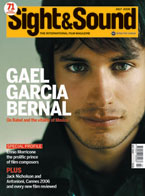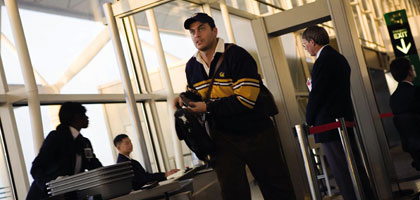Primary navigation

USA/UK/France 2006

Reviewed by Ali Jaafar
Our synopses give away the plot in full, including surprise twists.
America, 11 September 2001. A reenactment of the events surrounding 9/11. After the first plane is hijacked, United Airlines Flight 93 prepares to take off from Newark, New Jersey. At first, the terrorist threat is undetected by aviation authorities who initially believe a light plane has accidentally collided into the north tower of New York's World Trade Center. As the second plane careers into the centre's south tower, it becomes apparent that America is under attack.
Once in the air United Airlines Flight 93 is hijacked by four men, led by Ziad Jarrah, who pilots the plane. The passengers find out about the other attacks from phone calls with friends and family. They decide to try to retake the cockpit. After overpowering the two terrorists guarding them, one of whom has fake explosives strapped to his waist, they attempt to storm the cockpit. As the struggle intensifies, Jarrah sends the plane crashing into the ground. The screen fades to black.
Of the four flights hijacked during 9/11, the story of United Airlines Flight 93, whose passengers fought back against the hijackers, lent itself most readily to the patriotic fervour that followed the day's events.
Tom Ridge, the inaugural US secretary of homeland security (a post created in the wake of 9/11) hailed the "citizen soldiers" on board, while Todd Beamer's reported invocation to his fellow passengers to challenge the terrorists, "let's roll", became an iconic phrase, invoked by both President Bush in a key policy speech and the Canadian musician Neil Young in a specially penned song. Now British director Paul Greengrass recreates the events of the flight in United 93.
Prior to its release both the film and its director were accused of exploiting real-life tragedy, not least because the events portrayed took place less than five years ago. But a strong opening in America suggests audiences there are ready to revisit 9/11 onscreen. And Greengrass treats his subject matter with serious-minded sensitivity. The victims' families were consulted throughout the film's production, while 10 per cent of the first weekend's box-office receipts were donated to the Flight 93 National Memorial Fund. United 93's production notes feature obituaries of the passengers. Also adding to the reverential tone is the fact that a number of air-traffic officials working that day play themselves, most notably Ben Sliney, the then US Federal Aviation Authority's national operations manager.
Greengrass uses the stripped-down docudrama aesthetic he previously deployed in The Murder of Stephen Lawrence (1999) and Bloody Sunday (2001); it is a very British genre for such an American story. The knowledge the viewer has of the passengers' fate lends the vérité approach an often overwhelming sense of claustrophobic doom, as when the mundane sight of a fuel rig connected to the plane evokes the devastating impact of the fuel-heavy aircraft that crashed into the World Trade Center. There is a meticulous eye for detail, too: in one scene, for example, the glint of a green passport protruding from the hand of one of the boarding hijackers betrays his Saudi origins.
The geo-political dimensions of the story are largely left in the background, the director preferring to follow chronologically and in microscopic detail that clear, almost cloudless morning's descent into ash-filled horror. Significant portions of United 93 are set not on the flight but in the control rooms of the various air traffic-control centres around the east coast of America. Some bravura editing conveys the growing panic and incomprehension as planes disappear from radar screens and a murky voice, transmitted from the cockpit of one of the first two planes to be hijacked, says: "We have some planes." The chaotic bewilderment reaches its nadir as the chains of communication and command between the military and the civilian authorities fall apart when the World Trade Center is hit for a second time. The shock of the familiar is made devastatingly new on the stunned reactions of the officials.
What also comes out of these scenes, largely drawn from interviews Greengrass' team conducted with participants and from the report of the US government's 9/11 Commission into the events, is a firm rebuttal of the conspiracy theories surrounding Flight 93, most notably that the plane was shot down by US fighter jets. A title card at the end of the film states that a presidential order to scramble jets into American airspace on 9/11 only came after Flight 93 had already been downed.
It is with the scenes onboard Flight 93 that it is least clear what the film is attempting to achieve. Dramatic reconstructions of this kind tend to contain elements of advocacy, such as attempts to right an injustice as in Errol Morris' The Thin Blue Line (1988) or to shed light on an unsolved crime as in The Murder of Stephen Lawrence. There are no shock discoveries or accusatory revelations in United 93. Greengrass shot much of the film at Britain's Pinewood Studios, possibly to shelter his cast and crew from the emotions a US-based production might have provoked. The director repeatedly instructed his cast to re-enact the 91-minute flight in its entirety, their improvisations executed within the parameters of known facts on the ground and in the air. This element of conjecture, particularly when placed within the context of other unchallenged truths, inevitably leads to charges of voyeurism.
That said, the scenes on the plane are respectfully handled by Greengrass, who eschews bombast or mawkish sentimentality. Even the "let's roll" moment is underplayed. This desire to avoid jingoism is also evident in the final, tasteful postscripts. An early cut of the film reportedly ended with the words "America's war on terror had begun". The final version ends with the more sober "dedicated to the memory of all those who lost their lives on September 11th, 2001", a sentiment in keeping with the film's memorial tone, and its tribute to the actions not of a nation but of a handful of ordinary people. "If you look clearly and unflinchingly at a single event, you can find in its shape something much larger than... the event itself - the DNA of our times," Greengrass has said. If that is the case, then United 93 terrifyingly conveys the nature of the threat facing the world today and poignantly conveys onscreen the decision by a few brave individuals to fight back.